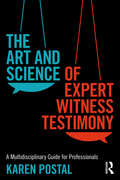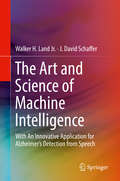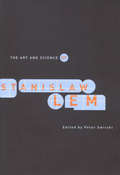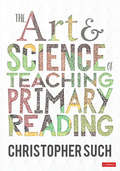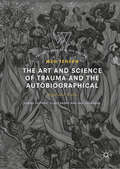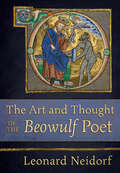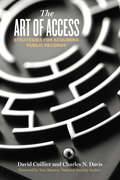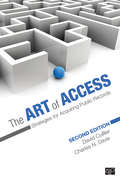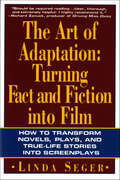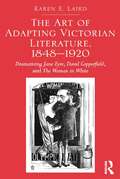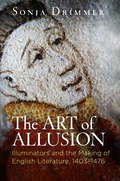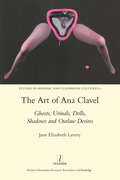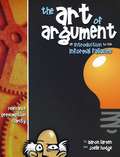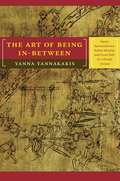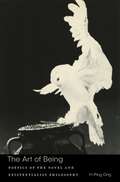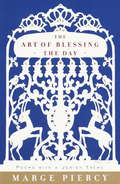- Table View
- List View
The Art and Craft of Writing Historical Fiction
by James Alexander ThomOnce Upon a Time, it was NOW... While a historian stands firmly planted in the present and looks back into the past, a historical novelist has a more immediate task: to set readers in the midst of bygone events and lead them forward, allowing them to live and feel the wonderment, fear, hope, triumph, and pain as if they were there. In The Art and Craft of Writing Historical Fiction, best-selling author James Alexander Thom (Follow the River, From Sea to Shining Sea, Sign-Talker) gives you the tools you need to research and create stories born from the past that will move and inspire modern readers. His comprehensive approach includes lessons on how to: Find and use historical archives and conduct physical field research Re-construct the world of your novel, including people and voices, physical environments, and cultural context Achieve verisimilitude in speech, action, setting, and description Seamlessly weave historical fact with your own compelling plot ideas With wit and candor, Thom's detailed instruction, illuminating personal experience, and invaluable insights culled from discussions with other trusted historical writers will guide you to craft a novel that is true to what was then, when then was now.
The Art and Imagination of Langston Hughes
by R. Baxter MillerThis is one of the first studies to apply recent methods of literary analysis, including formal, structural and semiotic criticism, to the work of a Black American writer.
The Art and Science of Expert Witness Testimony: A Multidisciplinary Guide for Professionals
by Karen PostalFeaturing in-depth interviews of attorneys, judges, and seasoned forensic experts from multiple disciplines including psychology, medicine, economics, history, and neuropsychology, The Art and Science of Expert Witness Testimony highlights and offers bridges for the areas where the needs and expectations of the courtroom collide with experts’ communication habits developed over years of academic and professional training. Rather than seeing testimony as a one-way download from expert to jurors, The Art and Science of Expert Witness Testimony focuses on the direct, dynamic, unique communication relationship that develops as each juror’s lived experience interacts with the words of experts on the stand. This book expands the academic tradition of "methods-centered credibility" to also include "person-centered credibility," where warmth, confidence, and relentless attention to detail build trust with jurors. Seasoned forensic experts share what they actually say on the stand: their best strategies and techniques for disrupting traditional academic communication and creating access to science and professional opinions with vivid, clear language and strong visuals. The difficult but necessary emotional work of the courtroom is addressed with specific techniques to regulate emotions in order to maintain person-centered credibility and keep the needs of jurors front and center through cross-examination. This innovative compilation of research is essential reading for professionals and practitioners, such as physicians, engineers, accountants, and scientists, that may find themselves experts in a courtroom. The Art and Science of Expert Witness Testimony provides a unique experience for readers, akin to being personally mentored by over eighty-five attorneys, judges, and seasoned experts as they share their observations, insights, and strategies—not to "win" as a defense, prosecution, or plaintiff expert, but to be productive in helping jurors and other triers of fact do their difficult intellectual job in deciding a case.
The Art and Science of Machine Intelligence: With An Innovative Application for Alzheimer’s Detection from Speech
by J. David Schaffer Walker H. Land Jr.This volume presents several machine intelligence technologies, developed over recent decades, and illustrates how they can be combined in application. One application, the detection of dementia from patterns in speech, is used throughout to illustrate these combinations. This application is a classic stationary pattern detection task, so readers may easily see how these combinations can be applied to other similar tasks. The expositions of the methods are supported by the basic theory they rest upon, and their application is clearly illustrated. The book’s goal is to allow readers to select one or more of these methods to quickly apply to their own tasks.Includes a variety of machine intelligent technologies and illustrates how they can work togetherShows evolutionary feature subset selection combined with support vector machines and multiple classifiers combinedIncludes a running case study on intelligent processing relating to Alzheimer’s / dementia detection, in addition to several applications of the machine hybrid algorithms
The Art and Science of Stanislaw Lem
by Peter SwirskiRather than analyzing Lem solely as a science fiction writer, the contributors examine the larger themes in his work, such as social engineering and human violence, agency and consciousness, Freudianism and the creative process, evolution and the philosophy of the future, virtual reality and epistemological illusion, and science fiction and socio-cultural policy.
The Art and Science of Stanislaw Lem
by Peter SwirskiThe Polish science fiction writer Stanislaw Lem, whose works include Return from the Stars, The Cyberiad, A Perfect Vacuum, and Solaris, has been hailed as a "literary Einstein" and a science-fiction Bach. The Art and Science of Stanislaw Lem provides an inter-disciplinary analysis of his influence on Western culture and the creative partnering of art and science in his fiction and futorology by American and European scholars who have defined Lem scholarship. Rather than analyzing Lem solely as a science fiction writer, the contributors examine the larger themes in his work, such as social engineering and human violence, agency and consciousness, Freudianism and the creative process, evolution and the philosophy of the future, virtual reality and epistemological illusion, and science fiction and socio-cultural policy. This unique collection also includes "Smart Robots," a previously unpublished essay by Lem. Contributors include Peter Butko (Southern Mississippi), Istvan Csicsery-Ronay Jr (DePauw), Katherine Hayles (California at Los Angeles), Jerzy Jarzebski (Jagiellonian, University Cracow), Michael Kandel (Modern Language Association), Stanislaw Lem, Paisley Livingston (Lingnan University, Hong Kong), Krzysztof Loska (Jagiellonian University), and Peter Swirski (Hong Kong).
The Art and Science of Teaching Primary Reading (Corwin Ltd)
by Christopher SuchThe essential guide to the science behind reading and its practical implications for classroom teaching in primary schools. Teaching children to read is one of the most important tasks in primary education and classroom practice needs to be underpinned by a secure foundation of knowledge. Teachers need to know what reading entails, how children learn to read and how it can be taught effectively. This book is an essential guide for primary teachers that explores the key technical and practical aspects of how children read with strong links to theory and how to translate this into the classroom. Bite-size chapters offer accessible research-informed ideas across all major key topics including phonics, comprehension, teaching children with reading difficulties and strategies for the classroom. Key features include: · Discussions of implications for the classroom · Questions for further professional discussions · Retrieval quizzes · Further reading suggestions · Glossary of key terms Christopher Such is a primary school teacher and the author of the education blog Primary Colour. He can be found on Twitter via @Suchmo83.
The Art and Science of Teaching Primary Reading (Corwin Ltd)
by Christopher SuchThe essential guide to the science behind reading and its practical implications for classroom teaching in primary schools. Teaching children to read is one of the most important tasks in primary education and classroom practice needs to be underpinned by a secure foundation of knowledge. Teachers need to know what reading entails, how children learn to read and how it can be taught effectively. This book is an essential guide for primary teachers that explores the key technical and practical aspects of how children read with strong links to theory and how to translate this into the classroom. Bite-size chapters offer accessible research-informed ideas across all major key topics including phonics, comprehension, teaching children with reading difficulties and strategies for the classroom. Key features include: · Discussions of implications for the classroom · Questions for further professional discussions · Retrieval quizzes · Further reading suggestions · Glossary of key terms Christopher Such is a primary school teacher and the author of the education blog Primary Colour. He can be found on Twitter via @Suchmo83.
The Art and Science of Trauma and the Autobiographical: Negotiated Truths (Palgrave Studies in Life Writing)
by Meg JensenThis book examines posttraumatic autobiographical projects, elucidating the complex relationship between the ‘science of trauma’ (and how that idea is understood across various scientific disciplines), and the rhetorical strategies of fragmentation, dissociation, reticence and repetitive troping widely used the representation of traumatic experience. From autobiographical fictions to prison poems, from witness testimony to autography, and from testimonio to war memorials, otherwise dissimilar projects speak of past suffering through a limited and even predictable discourse in search of healing. Drawing on approaches from literary, human rights and cultural studies that highlight relations between trauma, language, meaning and self-hood, and the latest research on the science of trauma from the fields of clinical, behavioral and evolutionary psychology and neuroscience, I read such autobiographical projects not as ‘symptoms’ but as complex interrogative negotiations of trauma and its aftermath: commemorative and performative narratives navigating aesthetic, biological, cultural, linguistic and emotional pressure and inspiration.
The Art and Thought of the "Beowulf" Poet
by Leonard NeidorfIn The Art and Thought of the Beowulf Poet, Leonard Neidorf explores the relationship between Beowulf and the legendary tradition that existed prior to its composition. The Beowulf poet inherited an amoral heroic tradition, which focused principally on heroes compelled by circumstances to commit horrendous deeds: fathers kill sons, brothers kill brothers, and wives kill husbands. Medieval Germanic poets relished the depiction of a hero's unyielding response to a cruel fate, but the Beowulf poet refused to construct an epic around this traditional plot. Focusing instead on a courteous and pious protagonist's fight against monsters, the poet creates a work that is deeply untraditional in both its plot and its values. In Beowulf, the kin-slayers and oath-breakers of antecedent tradition are confined to the background, while the poet fills the foreground with unconventional characters, who abstain from transgression, display courtly etiquette, and express monotheistic convictions. Comparing Beowulf with its medieval German and Scandinavian analogues, The Art and Thought of the Beowulf Poet argues that the poem's uniqueness reflects one poet's coherent plan for the moral renovation of an amoral heroic tradition. In Beowulf, Neidorf discerns the presence of a singular mind at work in the combination and modification of heroic, folkloric, hagiographical, and historical materials. Rather than perceive Beowulf as an impersonally generated object, Neidorf argues that it should be read as the considered result of one poet's ambition to produce a morally edifying, theologically palatable, and historically plausible epic out of material that could not independently constitute such a poem.
The Art of Access: Strategies for Acquiring Public Records
by Charles Davis David L. CuillierWhatever you're trying to learn about the world—as a journalist or as an informed citizen— public records often hold the key. But what records, where? And how to get them? It starts with understanding the Freedom of Information Act, but what you really need are strategies for dealing with the officials who stand between you and the information you seek. Gaining access to records is an art, one that requires an organized approach and a good understanding of human behavior.
The Art of Access: Strategies for Acquiring Public Records
by Charles N. Davis David L. CuillierWhatever you’re trying to learn about the world—as a journalist or as an informed citizen— public records often hold the key. But what records, where? And how to get them? Gaining access to records is an art, one that requires an organized approach and a good understanding of human behavior. The Art of Access: Strategies for Acquiring Public Records, Second Edition is a how-to guide for putting the law into action and using ingenuity to pry records loose. FOI experts and longtime journalists David Cuillier and Charles N. Davis present strategies for dealing with the officials who stand between you and the information you seek. They explore new developments in technology and research and the latest online innovations and tools to help you rethink the information-gathering process and develop a document state of mind.
The Art of Access: Strategies for Acquiring Public Records
by Charles N. Davis David L. CuillierWhatever you’re trying to learn about the world—as a journalist or as an informed citizen— public records often hold the key. But what records, where? And how to get them? Gaining access to records is an art, one that requires an organized approach and a good understanding of human behavior. The Art of Access: Strategies for Acquiring Public Records, Second Edition is a how-to guide for putting the law into action and using ingenuity to pry records loose. FOI experts and longtime journalists David Cuillier and Charles N. Davis present strategies for dealing with the officials who stand between you and the information you seek. They explore new developments in technology and research and the latest online innovations and tools to help you rethink the information-gathering process and develop a document state of mind.
The Art of Adaptation: Turning Fact and Fiction into Film
by Linda SegerAdaptations have long been a mainstay of Hollywood and the television networks. Indeed, most Academy Award- and Emmy Award-winning films have been adaptations of novels, plays, or true-life stories. Linda Seger, author of two acclaimed books on scriptwriting, now offers a comprehensive handbook for screenwriters, producers, and directors who want to successfully transform fictional or factual material into film. Seger tells how to analyze source material to understand why some of it resists adaptation. She then gives practical methods for translating story, characters, themes, and style into film. A final section details essential information on how to adapt material and how to protect oneself legally.
The Art of Adapting Victorian Literature, 1848-1920: Dramatizing Jane Eyre, David Copperfield, and The Woman in White
by Karen E. LairdIn The Art of Adapting Victorian Literature, 1848-1920, Karen E. Laird alternates between readings of nineteenth-century stage and twentieth-century silent film adaptations to investigate the working practices of the first adapters of Victorian fiction. Laird’s juxtaposition between stage and screen brings to life the dynamic culture of literary adaptation as it developed throughout the long nineteenth-century. Focusing on Charlotte Brontë’s Jane Eyre, Charles Dickens’s David Copperfield, and Wilkie Collins’s The Woman in White, Laird demonstrates how adaptations performed the valuable cultural work of expanding the original novel’s readership across class and gender divides, exporting the English novel to America, and commemorating the novelists through adaptations that functioned as virtual literary tourism. Bridging the divide between literary criticism, film studies, and theatre history, Laird’s book reveals how the Victorian adapters set the stage for our contemporary film adaptation industry.
The Art of Alibi: English Law Courts and the Novel
by Jonathan H. GrossmanIn The Art of Alibi, Jonathan Grossman reconstructs the relation of the novel to nineteenth-century law courts. During the Romantic era, courthouses and trial scenes frequently found their way into the plots of English novels. As Grossman states, "by the Victorian period, these scenes represented a powerful intersection of narrative form with a complementary and competing structure for storytelling." He argues that the courts, newly fashioned as a site in which to orchestrate voices and reconstruct stories, arose as a cultural presence influencing the shape of the English novel.Weaving examinations of novels such as William Godwin's Caleb Williams, Mary Shelley's Frankenstein, and Charles Dickens's The Pickwick Papers and Oliver Twist, along with a reading of the new Royal Courts of Justice, Grossman charts the exciting changes occurring within the novel, especially crime fiction, that preceded and led to the invention of the detective mystery in the 1840s.
The Art of Allusion: Illuminators and the Making of English Literature, 1403-1476 (Material Texts)
by Sonja DrimmerAt the end of the fourteenth and into the first half of the fifteenth century Geoffrey Chaucer, John Gower, and John Lydgate translated and revised stories with long pedigrees in Latin, Italian, and French. Royals and gentry alike commissioned lavish manuscript copies of these works, copies whose images were integral to the rising prestige of English as a literary language. Yet despite the significance of these images, manuscript illuminators are seldom discussed in the major narratives of the development of English literary culture.The newly enlarged scale of English manuscript production generated a problem: namely, a need for new images. Not only did these images need to accompany narratives that often had no tradition of illustration, they also had to express novel concepts, including ones as foundational as the identity and suitable representation of an English poet. In devising this new corpus, manuscript artists harnessed visual allusion as a method to articulate central questions and provide at times conflicting answers regarding both literary and cultural authority.Sonja Drimmer traces how, just as the poets embraced intertexuality as a means of invention, so did illuminators devise new images through referential techniques—assembling, adapting, and combining images from a range of sources in order to answer the need for a new body of pictorial matter. Featuring more than one hundred illustrations, twenty-seven of them in color, The Art of Allusion is the first book devoted to the emergence of England's literary canon as a visual as well as a linguistic event.
The Art of Ana Clavel: Ghosts, Urinals, Dolls, Shadows and Outlaw Desires
by JaneElizabeth LaveryAna Clavel is a remarkable contemporary Mexican writer whose literary and multimedia oeuvre is marked by its queerness. The queer is evinced in the manner in which she disturbs conceptions of the normal not only by representing outlaw sexualities and dark desires but also by incorporating into her fictive and multimedia worlds that which is at odds with normalcy as evinced in the presence of the fantastical, the shadow, ghosts, cyborgs, golems and even urinals. Clavels literary trajectory follows a queer path in the sense that she has moved from singular modes of creative expression in the form of literary writing, a traditional print medium, towards other non-literary forms. Some of Clavels works have formed the basis of wider multimedia projects involving collaboration with various artists, photographers, performers and IT experts. Her works embrace an array of hybrid forms including the audiovisual, internet-enabled technology, art installation, (video) performance and photography. By foregrounding the queer heterogeneous narrative themes, techniques and multimedia dimension of Clavels oeuvre, the aim of this monograph is to attest to her particular contribution to Hispanic letters, which arguably is as significant as that of more established Spanish American boom femenino women writers.
The Art of Argument: An Introduction to the Informal Fallacies
by Joelle Hodge Aaron LarsenJunior high aged students will argue (and sometimes quarrel), but they won't argue well without good training. Young teens are also targeted by advertisers with a vengeance. From billboards to commercials to a walk down the mall, fallacious arguments are everywhere you look. The Art of Argument was designed to teach the argumentative adolescent how to reason with clarity, relevance and purpose at a time when he has a penchant for the why and how. It is designed to equip and sharpen young minds as they live, play, and grow in this highly commercial culture. This course teaches students to recognize and identify twenty-eight informal fallacies, and the eye-catching text includes over sixty slick and clever, phony advertisements for items from blue jeans to pick-up trucks, which apply the fallacies to a myriad of real life situations.
The Art of Asking Questions
by Stanley PayneWhile the statisticians are trying to knock a few tenths off the statistical error, says Mr. Payne, errors of tens of percents occur because of bad question wording. Mr. Payne's shrewd critique of the problems of asking questions reveals much about the nature of language and words, and a good deal about the public who must answer the poller's questions.
The Art of Being In-Between: Native Intermediaries, Indian Identity, and Local Rule in Colonial Oaxaca
by Yanna YannakakisIn The Art of Being In-between Yanna Yannakakis rethinks processes of cultural change and indigenous resistance and accommodation to colonial rule through a focus on the Sierra Norte of Oaxaca, a rugged, mountainous, ethnically diverse, and overwhelmingly indigenous region of colonial Mexico. Her rich social and cultural history tells the story of the making of colonialism at the edge of empire through the eyes of native intermediary figures: indigenous governors clothed in Spanish silks, priests' assistants, interpreters, economic middlemen, legal agents, landed nobility, and "Indian conquistadors. " Through political negotiation, cultural brokerage, and the exercise of violence, these fascinating intercultural figures redefined native leadership, sparked indigenous rebellions, and helped forge an ambivalent political culture that distinguished the hinterlands from the centers of Spanish empire. Through interpretation of a wide array of historical sources--including descriptions of public rituals, accounts of indigenous rebellions, idolatry trials, legal petitions, court cases, land disputes, and indigenous pictorial histories--Yannakakis weaves together an elegant narrative that illuminates political and cultural struggles over the terms of local rule. As cultural brokers, native intermediaries at times reconciled conflicting interests, and at other times positioned themselves in opposing camps over the outcome of municipal elections, the provision of goods and labor, landholding, community ritual, the meaning of indigenous "custom" in relation to Spanish law, and representations of the past. In the process, they shaped an emergent "Indian" identity in tension with other forms of indigenous identity and a political order characterized by a persistent conflict between local autonomy and colonial control. This innovative study provides fresh insight into colonialism's disparate cultures and the making of race, ethnicity, and the colonial state and legal system in Spanish America.
The Art of Being: Poetics of the Novel and Existentialists Philosophy
by Yi-Ping OngIn this account of how the novel reorients philosophy toward the meaning of existence, Yi-Ping Ong shows that the existentialists discovered a radical way of thinking about the relation between the form of the novel and the nature of self-knowledge, freedom, and the world. At stake are the conditions under which knowledge of existence is possible.
The Art of Bible Translation
by Robert AlterAn award-winning biblical translator reflects on the art of capturing the literary power of the Bible in EnglishIn this brief book, award-winning biblical translator and acclaimed literary critic Robert Alter offers a personal and passionate account of what he learned about the art of Bible translation over the two decades he spent completing his own English version of the Hebrew Bible.Alter’s literary training gave him the advantage of seeing that a translation of the Bible can convey the text’s meaning only by trying to capture the powerful and subtle literary style of the biblical Hebrew, something the modern English versions don’t do justice to. The Bible’s style, Alter writes, “is not some sort of aesthetic embellishment of the ‘message’ of Scripture but the vital medium through which the biblical vision of God, human nature, history, politics, society, and moral value is conveyed.” And, as the translators of the King James Version knew, the authority of the Bible is inseparable from its literary authority.For these reasons, the Bible can be brought to life in English only by re-creating its literary virtuosity, and Alter discusses the principal aspects of style in the Hebrew Bible that any translator should try to reproduce: word choice, syntax, word play and sound play, rhythm, and dialogue. In the process, he provides an illuminating and accessible introduction to biblical style that also offers insights about the art of translation far beyond the Bible.
The Art of Blessing the Day
by Marge PiercyWinner of the 2000 Paterson Poetry PrizeAbout Marge Piercy's collection of her old and new poems that celebrate the Jewish experience, the poet Lyn Lifshin writes: "The Art of Blessing the Day is an exquisite book. The whole collection is strong, passionate, and poignant, but the mother and daughter poems, fierce and emotional, with their intense ambivalence, pain and joy, themes of separation and reconnecting, are among the very strongest about that difficult relationship."These striking, original, beautifully sensuous poems do just that. Ordinary moments--a sunset, a walk, a private religious ritual--are so alive in poems like 'Shabbat moment' and 'Rosh Hodesh.' In the same way that she celebrates ordinary moments, small things become charged with memories and feelings: paper snowflakes, buttons, one bird, a bottle-cap flower made from a ginger ale top and crystal beads. "She celebrates the body in rollicking, gusto-filled poems like 'Belly good' and 'The chuppah,' where 'our bodies open their portals wide.' So much that is richly sensuous: 'hands that caressed you, . . . untied the knot of pleasure and loosened your flesh till it fluttered,' and lush praise for 'life in our spines, our throats, our knees, our genitals, our brains, our tongues.'"I love the humor in poems like 'Eat fruit,' the nostalgia and joy in 'The rabbi's granddaughter and the Christmas tree,' the fresh, beautiful images of nature--'In winter . . .the sun hangs its wizened rosehip in the oaks.'"I admire Piercy's sense of the past alive in the present, in personal and social history. The poems are memorials, like the yahrtzeit candle in a glass. 'We lose and we go on losing,' but the poems are never far from harsh joy, the joy that is 'the wine of life.'"Growing up haunted by Holocaust ghosts is an echo throughout the book, and some of the strongest poems are about the Holocaust, poems that become the voices of those who had no voice: 'What you carry in your blood is us, the books we did not write, music we could not make, a world gone from gristle to smoke, only as real now as words can make it.'"Marge Piercy's words make such a moving variety of experiences beautifully and forcefully real."
The Art of Brevity: Crafting the Very Short Story
by Grant FaulknerWith increased compression, every word, every sentence matters more. A writer must learn how to form narratives around caesuras and crevices instead of strings of connections, to move a story through the symbolic weight of images, to master the power of suggestion.With elegant prose, deep readings of other writers, and scaffolded writing exercises, The Art of Brevity takes the reader on a lyrical exploration of compact storytelling, guiding readers to heighten their awareness of not only what appears on the page but also what doesn&’t.


